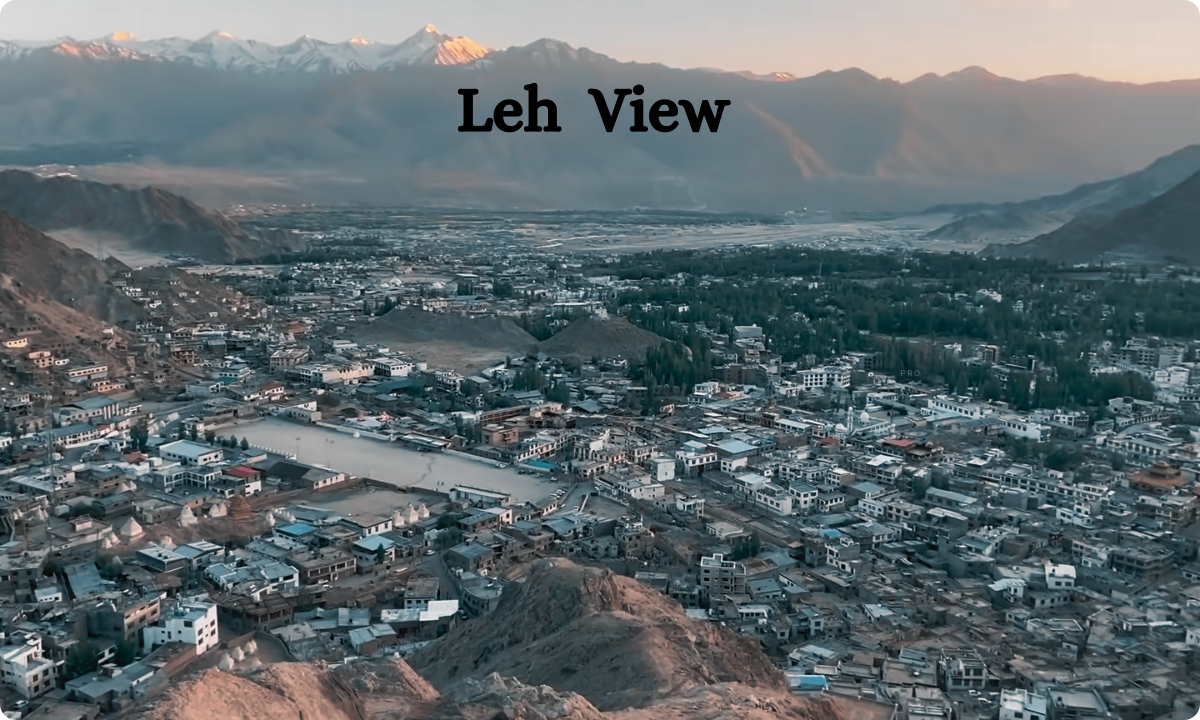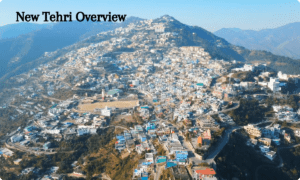Top 20 Places to Visit in Leh Ladakh One of the most stunning locations in India is without a doubt Leh, the capital of the Ladakh district, which is currently a Union Territory. Situated at a higher altitude, the accessibility is limited all year round, with road closures lasting up to half a year. Generally speaking, the roads are accessible from May through October.
The months of June, July, and August are thought to be the greatest for travel to Ladakh. Travelers are observed to be leaving the area during what is regarded as the busiest time of year for tourists. The tourism industry has grown tenfold in recent years, primarily because of the impact of popular culture and the fact that Ladakh has been featured in numerous Bollywood films, including 3 Idiots, Jab Tak hai Jaan, and Bhaag Milka Bhaag.
Set off on a journey to experience the stunning landscape of Ladakh, a must-visit Himalayan destination for all travelers. The high-altitude desert provides the ideal haven from the summer heatwave because it stays cool throughout the hottest months.
Top 20 Places to Visit in Leh Ladakh in 2024
- Pangong Tso Lake
- Nubra Valley
- Kargil
- Zanskar Valley
- Khardung La Pass
- Hemis National Park
- Tso Moriri Lake
- Lamayuru Monastery
- Spituk Monastery
- Stok Palace
- Magnetic Hill
- Alchi Monastery
- Likir Monastery
- Changthang Wildlife Sanctuary
- Umling La Pass
- Chadar Trek
- Phugtal Monastery
- Royal Leh Palace
- Gurdwara Pathar Sahib
- Thiksey Monastery
1. Pangong Tso Lake

About 150 kilometers (KM) from Leh, the Pangong Lake can be reached after a 5-hour drive over the 17,590-foot (5,360-meter) high Changla Pass (Chang-la).
This saltwater lake is the highest in the world, rising to a height of 4350 meters. It’s among nature’s greatest gifts to humanity. Stretching over 160 km, a third of it is in China and the other two thirds is the tourist feelings of joy. Pangong Tso, a Tibetan term meaning “High Grassland Lake,” is where Pangong Lake got its name.
Visitors from all over the world travel to Leh Ladakh to see this most valuable gem. The stunning lake’s most fascinating feature is how it alternates between blue, grey, and green hues throughout the day. Given that it’s one of the high-altitude lakes in Leh Ladakh, the winters are extremely hard. Summertime is the ideal time to take in Pangong Lake’s breathtaking scenery.
For years, Pangong Lake was a must-see tourist destination in Ladakh, but it wasn’t until the release of the Bollywood film 3 Idiots that Pangong gained popularity with travelers. Pangong was the location of 3 Idiot’s climax shoot. Following the movie’s release, there was an unexpected spike in the number of visitors to the lake.
2. Nubra Valley

One of the trendiest valleys in Ladakh is Nubra Valley. This valley, well-known for its smashing scenery, provides some of the most breathtaking views. Situated approximately 160 km from Leh city, the valley is among the most picturesque places in this area. You will be astounded by the seductive beauty of this valley, which boasts enormous mountains, desolate vistas, rugged terrain, monasteries, the desert, and charming villages. When you see the natural wonders, it makes you feel surreal.
The valley, which is in Ladakh’s northeastern border, is a great location for photographers and nature enthusiasts. There are countless shades to capture with your camera in this postcard-perfect location. Here, scenic beauty is abundantly bestowed by nature. This valley offers ample opportunities for all types of visitors—tourists, experienced travelers, bikers, and photographers—to become enthralled, captivated, and thrilled with its incredible natural mystery.
The valley requires an ILP (Inner Line Permit) for Indian tourists and a PAP (Protected Area Permit) for foreign nationals due to its proximity to the border. To avoid AMS (Acute Mountain Sickness), it is recommended that you spend at least two days in Leh getting adjusted to the altitude before heading for the Nubra valley. The average elevation in Nubra Valley is roughly 10,000 feet, or 30, 48 meters.
3. Kargil
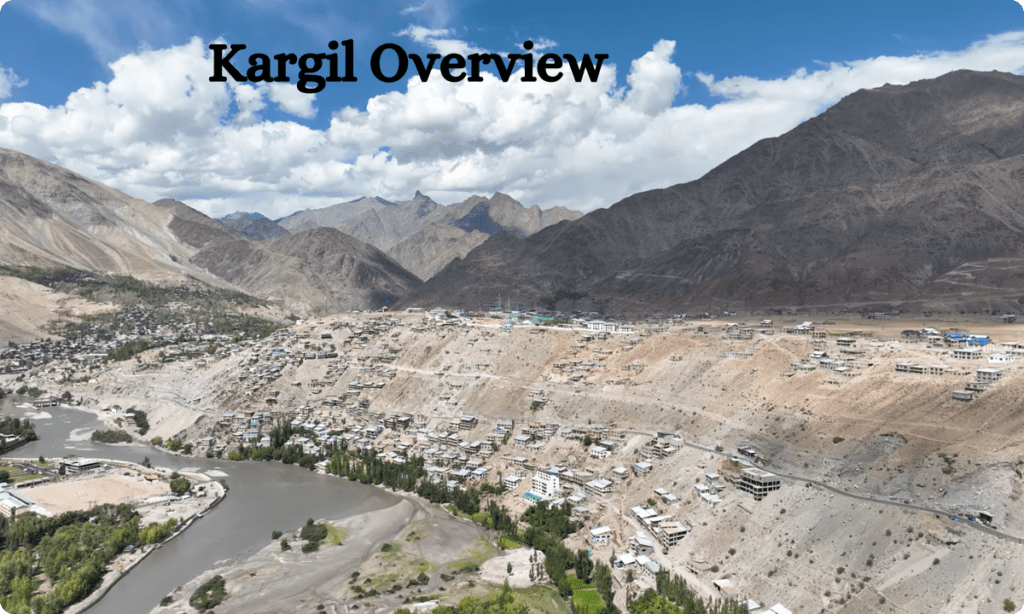
Kargil is situated on the Leh-Srinagar highway, 220 km from Leh and 210 km from Srinagar. It is one of the two districts and a major town of the Union Territory of Ladakh in India. Can say it’s a mid-point of Leh and Srinagar. Kargil is located approximately 8,700 feet above sea level on average. The town is located along the Suru River, an Indus tributary.
Indo-Pak LOC is located to the north of the town of Kargil. Extreme winter temperatures, occasionally falling below minus 40 degrees Celsius, are common in Kargil. 58 kilometers west of Kargil is Dras. An essential rest area along the Srinagar-Leh highway is Kargil. Many tourists travel to Kargil to witness the site and manner of the 1999 India-Pakistan war. The location of the Kargil War Memorial is in Dras.
4. Zanskar Valley
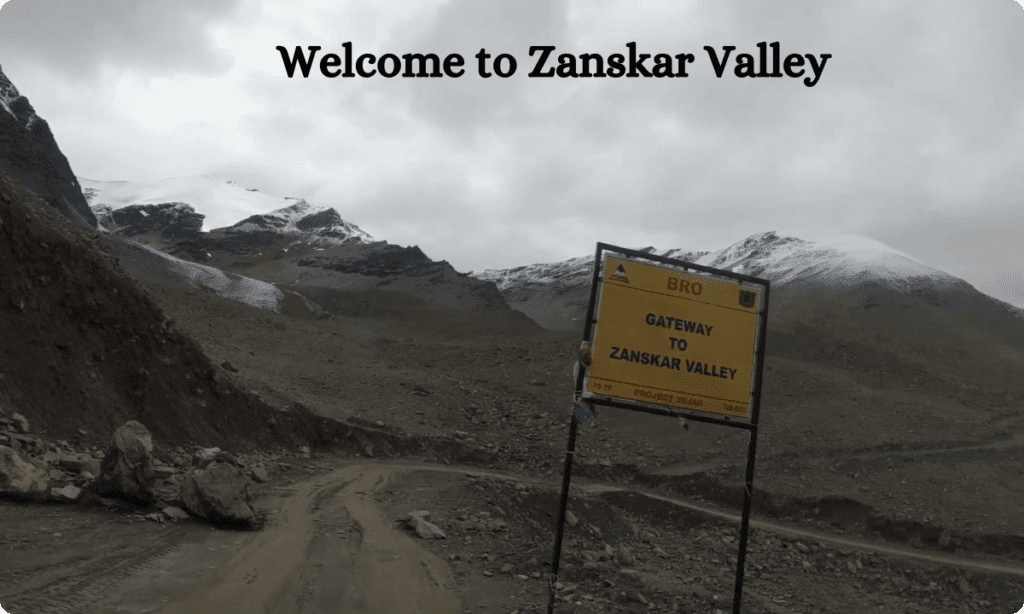
Zanskar Valley looks like an undiscovered world. Zanskar Valley, situated in the northern region of the Great Himalayas at an elevation of 13,154 feet, is geographically isolated and thus cut off from the outside world. Zanskar Valley has continued to be one of the finest examples of the traditional and cultural aspects of ancient Tibetan Buddhism, free from outside interference.
Winters in Zanskar are particularly hard. As low as -40 degrees Celsius are reached. As a result, the Zanskaris store for the winter and labor, trade, and travel in the summer. Zanskar Valley has never been easy to access. Zanskar was previously the only part of Ladakh connected to the outside world by the Kargil-Padum road. This road travels approximately 250 km and takes two days to complete. Few years back 2 more roads are opened to reach Zanskar valley. New routes are as follows
- Leh to Padum via Lingshed
- Traveling from Manali to Zanskar
5. Khardung La Pass
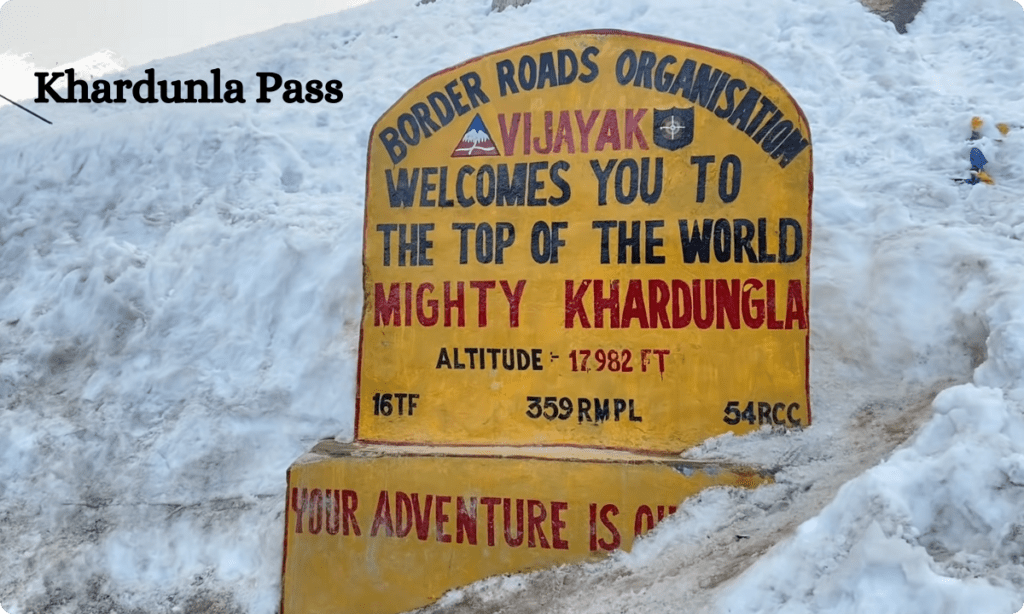
Known as the “Pass of Lower Castle” in Tibetan, the Khardung La Pass is frequently referred to as the world’s highest road. It’s in India, one of the most amazing and affordable travel destinations. It is the entry point to the Shoyk and Nubra valleys and is located about 40 km from Leh. It opened to the public in 1976.
In the winter, the road experiences temperatures as low as -40 degrees Celsius and up to 10 feet of snowfall. Furthermore, the oxygen concentrations are only about 50% of what is thought to be normal. The road that is highest in the world is not Khardung La Pass. It was reduced to two roads by the best sources I could find. Only a few miles from Khardungla is one of the world’s highest roads. The Ojos del Salado in Chile/Argentina is the other. Because the military maintains the road, a permit is needed to pass the first checkpoint.
6. Hemis National Park

Apart from this, another reason Ladakh is well-known is that it is the location of the largest national park in South Asia, Hemis National Park. Following the Nanda Devi Biosphere Reserve, it is also the second-largest contiguous protected area. Some of the rarest and most exotic species of flora and fauna can be found in Hemis National Park in Ladakh, which spans an area of over 4400 square kilometers. This national park’s large snow leopard population is its primary attract.
Hemis National Park, bordering by the Indus and Zaskar Rivers, is a well-liked vacation spot in Ladakh. This Ladakh national park, which lies between 3,300 and 6,000 meters above sea level, was created in 1981. It bears the name of the Hemis Monastery, which Lama Tagstang founded in 1630. This national park offers a variety of landscapes, including cold deserts, mountains, and flatlands. It’s the ideal place to spend some time taking in the best of nature’s beauty.
In addition to snow leopards, other wildlife found in this national park includes the Tibetan Argali, the Great Grey Shrike, the Black Throated Thrush, the Robin Acceptor, the Himalayan Whistling Thrush, and the Ladakh Urial. Alpine plants including Veronica, Anemone, Delphinium, Gentiana, Lloydia, and Kobresia make up the majority of the flora range.
7. Tso Moriri Lake
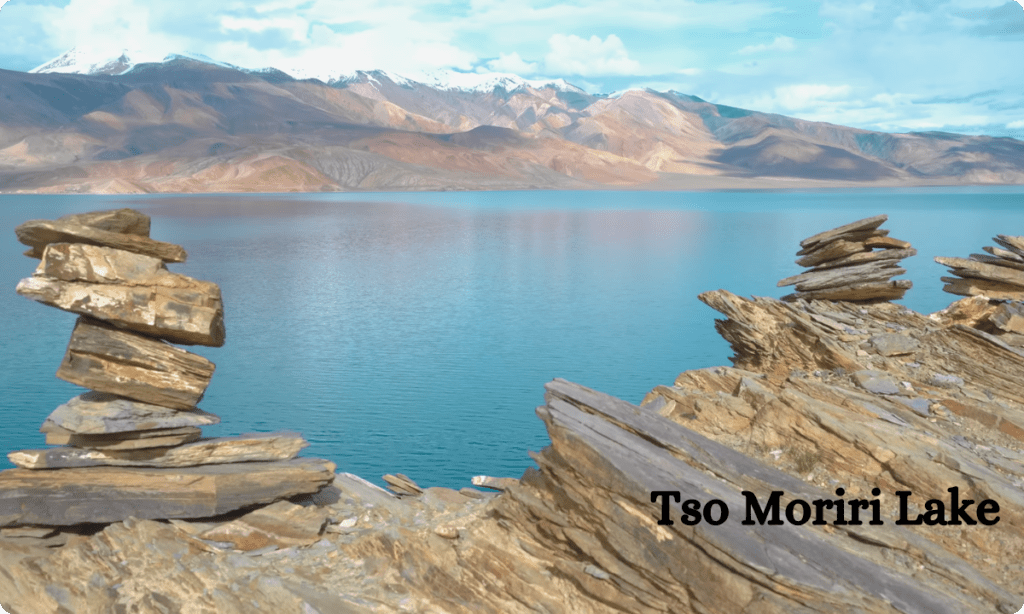
Located in the Changthang Region (Leh) of northern Ladakh, this lake is officially known as the Tso Moriri Wetland Conservation. Tso Moriri is a stunningly beautiful high-alpine lake in the Rupshu Valley. It is approximately 29 kilometers long and 8 kilometers wide, and it is located at an elevation of roughly 4500 meters above sea level. Leh and Tso Moriri are nearly two hundred kilometers away by road. Traveling from Leh to Tso Moriri takes approximately 6 hours.
After Tso Moriri was designated as a Ramsar site in 2002, it gained recognition on a global scale. Furthermore, this lake is important ecologically because it serves as a major migratory bird breeding ground. One of the best places to see an unspoiled landform is Tso Moriri Lake in Leh. The lake’s natural state is still present. You get the best environmental experience both during the day and at night.
Camping: While it is not possible to set up camp directly next to a lake, it is still ideal to do so at a safe distance away. Tourists find the serenity of the sunset and the brightness of the sunrise to be quite appealing. An amazing experience with nature can be had while camping.
Photography: Those who enjoy photography are drawn to using their cameras to capture a place’s ethereal beauty. Take pictures of the highlights of your journey to Tso Moriri and share them with your Instagram followers.
Bird Watching: The Tso Moriri is an ideal location for you if you enjoy watching birds with great interest. This is due to Tso Moriri’s status as a gathering place for migratory birds, including Black-necked cranes, Bar-headed geese, Greylag geese, and Northern Pintail. Nearly 300 different species of migratory birds call this area home, so you can take advantage of its natural beauty.
8. Lamayuru Monastery

The Lamayuru Monastery is located on the Leh-Srinagar highway at a height of 3510 meters. Around 125 kilometers from Leh, in Ladakh, lies an unusual but easily accessible village called Lamayuru. Lamayuru’s claim to fame, also known as the Moonland of Ladakh, is the unique geographical formation of moon-like landscapes carved into the larger Himalayas. The strange, amazing, and breathtaking terrain next to the monastery is said by some to resemble the soil on the moon, which explains the name.
Going back to the tenth century, the Lamayuru monastery is the largest gompa still in existence in Ladakh and one of the oldest monasteries in the region. One of the many legends surrounding it states that there once was a large lake in Lamayuru, which the village’s founding lama, Mahasiddhacharya Naropa, dried up to create the foundation for the monastery and village.
In Lamayuru, camping
On the Srinagar Leh Highway, there are numerous locations close to Lamayuru where you can set up camp and take advantage of the outdoor camping experience. There are places to set up camp even in the village of Lamayuru, or you can hike across mountains that resemble moonland.
Meditation and Yoga
Recently, Yogi Kyunga Rinpoche opened a yoga retreat center in Lamayuru, where monks practice meditation and spirituality under the guidance of Rinpoche’s leading disciple. The center was founded in the 1970s.
Trek Lamayuru
If you are interested in trekking in the Trans-Himalayas, there are a few treks that you can undertake around Lamayuru. There is a trek that takes roughly 18–20 days that goes from Lamayuru to Darcha over Zanskar. Afterwards, a five-day trek from Lamayuru to Wanla to Chilling is undertaken by some individuals.

9. Spituk Monastery

Known by its common name, Spituk Monastery, Spituk Gompa. The word “Spituk” means “outstanding,” and Rinchen Zangpo, a leading translator of Sanskrit Buddhist texts, has said that the monastery is renowned for its exemplary Buddhist community.I
It is located right next to the airport you so other than the monastery itself it is a good spot to collect some panoramic pictures of the entire Valley a lot of people that were just waiting for a plane to either land or take off so they could click a picture or make a Time Lapse video then the view will be even better
Due in large part to the migration of Tibetans brought about by the conflict between Tibet and China in the early centuries and even in recent decades, Tibetan Buddhism flourishes in Ladakh. Due to its proximity to both, Ladakh was impacted by the fighting.
Nonetheless, the Dalai Lama’s room and seat are what really caught my attention about this monastery. As for when the Dalai Lama visits this monastery, the monk we spoke with said that it happens on average once a year, though the exact date is variable. What felt like a synchronicity was that when we discovered the room, it was this same monk who urged us to go inside?
Leh is approximately eight kilometers away from the Spituk Monastery. Its construction is dated to the eleventh century CE. I took a brief tour of the monastery, but I had the good fortune to witness the Spituk Gustor winter festival. When planning a trip to Ladakh in January, be sure not to miss the festivities.
10. Stok Palace

Stoke Palace was constructed in 1820 for the use of the Ladakh royal family. However, when we arrived, I realized that it was no longer just a palace; instead, it was now a Heritage Hotel. Although it no longer felt like a tourist attraction, we still spent some time there.
The palace is situated approximately fifteen kilometers away from Leh. It is situated in a stunning area with a view of the valley and the surrounding Himalayan peaks.
A largely intact motorable road connects Stok to the town of Leh. From Leh, you have two options for transportation: your own car or a taxi. For some local sightseeing in Leh, you might also think about renting a bike.
11. Magnetic Hill
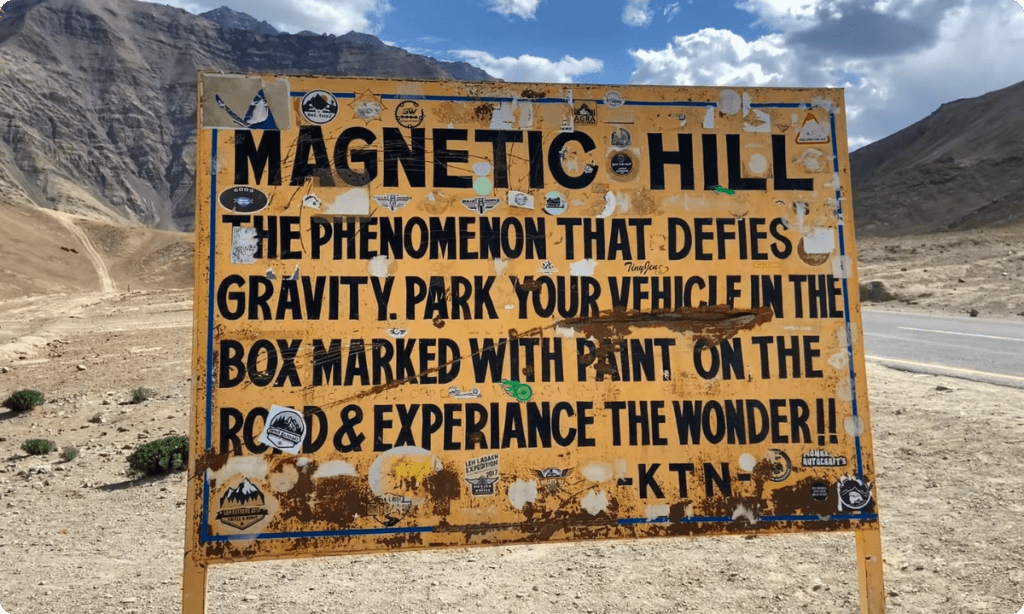
The Magnetic Hill in Leh is well-known for its an exception that defies gravity. Things fall downward when they are released from their natural gravitational pull toward the earth. But when things are released at this magnificent location, they seem to be traveling upward. What then is the reason behind this? First, let’s discuss geography.
At an elevation of 14,000 feet, Magnetic Hill is located somewhere along the Leh-Kargil-Srinagar National Highway in the Trans-Himalayan region. The hill is situated near the Sindhu river, which makes it a picturesque spot for pictures. Travelers to Leh Ladakh would all concur that one of the greatest locations to visit is Magnetic Hill.
Magnetic Hill is located about 30 km from Leh and is identified by a yellow signboard that says, “The Phenomenon That Defies Gravity.” On the road, there is a white box with a parking permit marked inside. Vehicles accelerate to nearly 20 km/h when parked in neutral at the designated spot. Magnet Road is the name of the road that the cars travel on.
12 Alchi Monastery
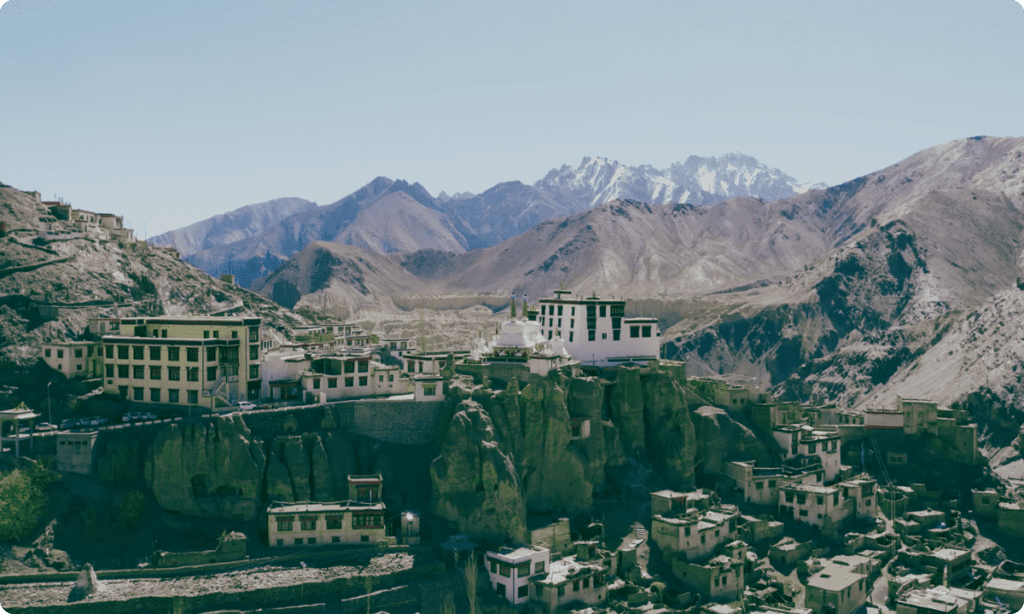
The Alchi Gompa or monastery. The Sham valley area and Alchi village are home to four distinct settlements within the monastery complex. This location is home to several monuments from different periods in history. Alchi is a part of the three villages that make up the “Alchi” group of monuments: Alchi, Mangyu, and Sumda Chun. Each of these three villages has a monument with distinctive workmanship and design.
The summer season during the festival season is the ideal time to visit Alchi Monastery. May through August are the best months because of the pleasant weather and the number of festivals that take place during this time of year. The principal festivals celebrated here are Chotrul Duchen, Galdan Namchot, Losar, Dajyur, and Sho Dunand Monlam.
The Alchi Monastery is located at a distance of 70 km from Leh city, The only other means of transportation from Leh to Alchi is via road Hotel and homestay options are available in Alchi. We can set you up with some fantastic properties that we have. The resorts and homestays we provide have running water, parking spaces, Wi-Fi, and cozy rooms.
13 Likir Monastery

Likir’s name translates to “The Naga – Encircled,” signifying the bodies of Nanda and Taksako, the two great a snake spirits known as the Naga-rajas. Likir Gompa is located next to the Indus River Valley on a hilltop.
The Likir Monastery was reconstructed in the 18th century, having originally been constructed in 1065. At 3,700 meters, it is perched at the top of a small hill outside the village in a very picturesque setting. The monastery’s 25-foot gold-covered Buddha statue is arguably its most well-known feature.
The road to Likir Monastery is well-connected. The road is smooth with a blacktop. About 50 km separate the monastery and Leh. From Leh, taxis are easily accessible. If you are traveling by private vehicle or bicycle, take the Leh-Srinagar highway for approximately 45 km and turn right at the welcome gate to Likir, which is located between Basgo and Saspol. Take the link road for approximately 6 km.
From the 27th to the 29th of the Tibetan calendar’s 12th month, the monastery celebrates the yearly Dosmoche festival. Based on the solar calendar, this is sometime in February. The festival took place from February 21 to February 23, 2024. In the upcoming years
14. Changthang Wildlife Sanctuary

Changtang Wildlife Sanctuary is a treasure for those who enjoy the outdoors, wildlife, and photography. It is home to some of the most rare and endangered wildlife species. It is interesting that Tsomoriri and Pangong Tso, two well-known high altitude lakes, are part of Changthang Cold Desert Wildlife Sanctuary. Furthermore, it has been noted that the sanctuary’s elevation varies between 14,000 and 19,000 feet. The Changthang Cold Desert Sanctuary has eleven lakes and ten marshes.
The snow leopard population is a unique feature of the wildlife sanctuary. Additionally, there are creatures like the Tibetan argali, wild yak, Tibetan wolf, and antelopes. The sanctuary is home to 44 different species of water birds, which is an interesting observation. The marshes serve as the Black-necked crane’s home before it soars to its wintering grounds.

The most important components and the unique feature that surprises you during your visit are the flora, fauna, and bird-based fauna.
May through December is the ideal time to visit Changthang Wildlife Sanctuary. Thus, you need to uncover this investigation with an amazing travel companion. To enter the Protected Area, you must first obtain permission from the District Magistrate Leh.
15. Umling La Pass
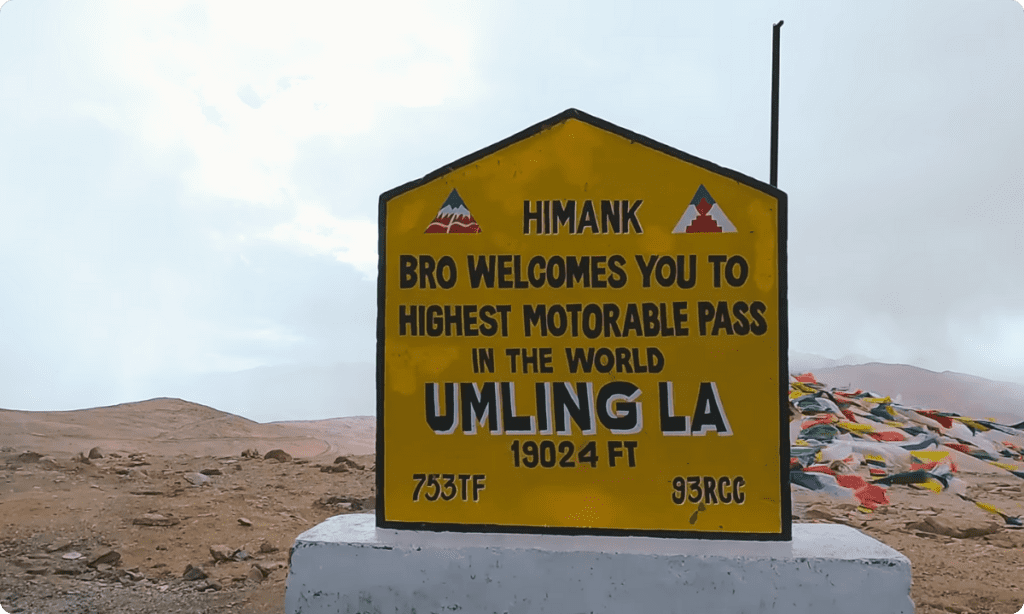
At 19024 feet, or 5798 meters, above sea level, Umling La Pass in Ladakh has surpassed both the Mana Pass in Uttarakhand and the road to Uturuncu in Bolivia to become the world’s highest motorable pass. In 2017, BRO opened the road to civilian traffic. Umling Pass was certified as the world’s highest motorable road by Guinness World Records in 2021.Leh to Umling La Pass distance is 275km.
The Umling La Pass is very close to the China-India Line of Actual Control. Indeed, the Changthang region surrounding Hanle and Umling La Pass is stunningly beautiful, but it’s also extremely harsh, unforgiving, and difficult to live in, particularly during the winter. Because of the extreme altitude and lack of oxygen, survival can be challenging if your body does not adjust to the new environment. With a height of 19024 feet, Umling La Pass falls in the very high altitude range.
16. Chadar Trek
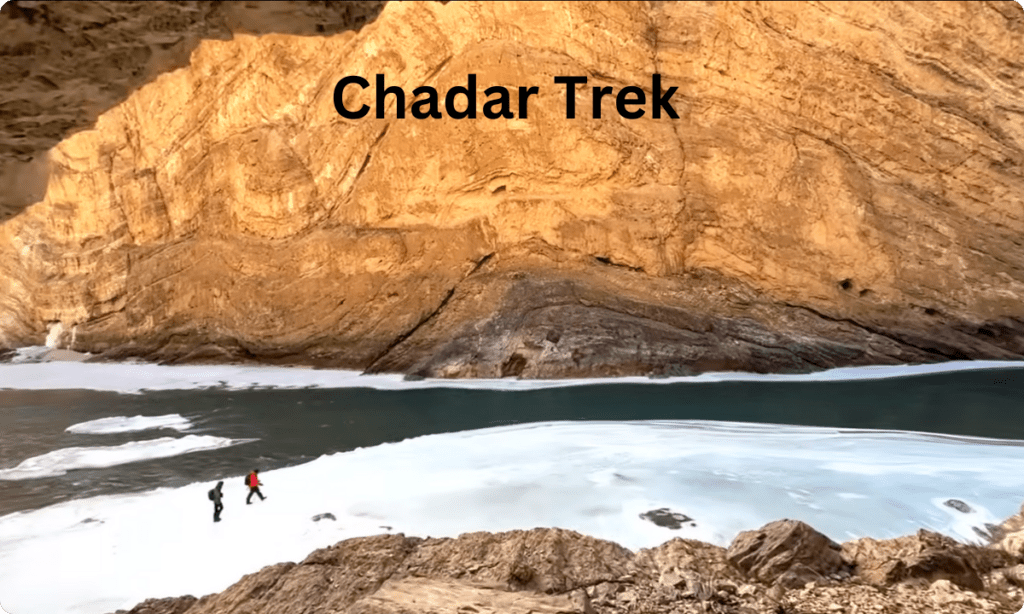
One of the most well-liked winter treks in India and the world’s most glamorous treks is the Chadar Trek in Ladakh. Because it requires walking on the frozen Zanskar River in extremely cold temperatures (between -15°C and -30°C), this trek is regarded as extremely difficult.
The word “Chadar” alludes to the white sheets of frozen river and means “blanket.” Between Zanskar Valley and Chilling, the Zanskar River meanders through a precipitous canyon. Since the road to Zanskar Valley is closed during the winter due to snowfall, the locals have historically used this route for trade. It became one of the most breathtaking winter treks in India as a result of the explorers who began to walk on the frozen river over time.
The Chadar Trek covers a distance of approximately 105 km, with a daily walking distance of 15–16 km from Chilling to Nerak and back. From an altitude of 3170 meters at the beginning of the trek to the higher camp at 3400 meters at Nerak, the walk is nearly level. But because of the severe weather, it’s regarded as a challenging trek.
17. Phugtal Monastery
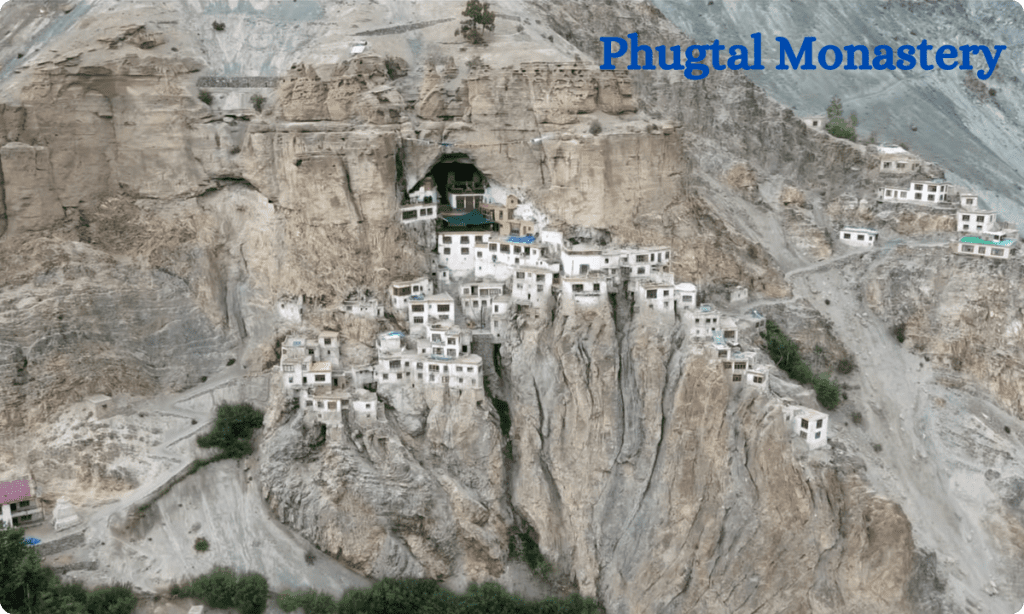
On an area of the gorge on the Tsarap Chu, a significant tributary of the Zanskar River, the monastery rises out of the mountainside. It appears to be a massive honeycomb from a distance. In fact, some refer to Phugtal monastery as both the cave monastery and the “Honeycomb Monastery.” Phugtal Monastery is certain to live up to your belief that monasteries possess a sense of mystery. The architecture is old and rustic, and it is rich in legend and history.
The Phugtal Monastery is a magnificent, lovely, and fascinating place. Understandably, it’s referred to as the “stairway to heaven.
Approximately one hundred monks currently reside in the monastery, which is still among Zanskar’s most isolated tourist destinations. The monastery is situated in a secluded area in the southeast of Zanskar Valley, in the Lungnak Valley. Trekking is one way to get to the monastery from Purne village or Chah village.
In the winter, heavy snowfall isolates Phugtal Monastery from the outside world. In fact, because of the heavy snowfall during the winter, Zanskar becomes cut off from other parts of Ladakh. During the winter, the only way to get to Zanskar is by foot across the frozen Zanskar River because the roads become blocked.
18. Royal Leh Palace
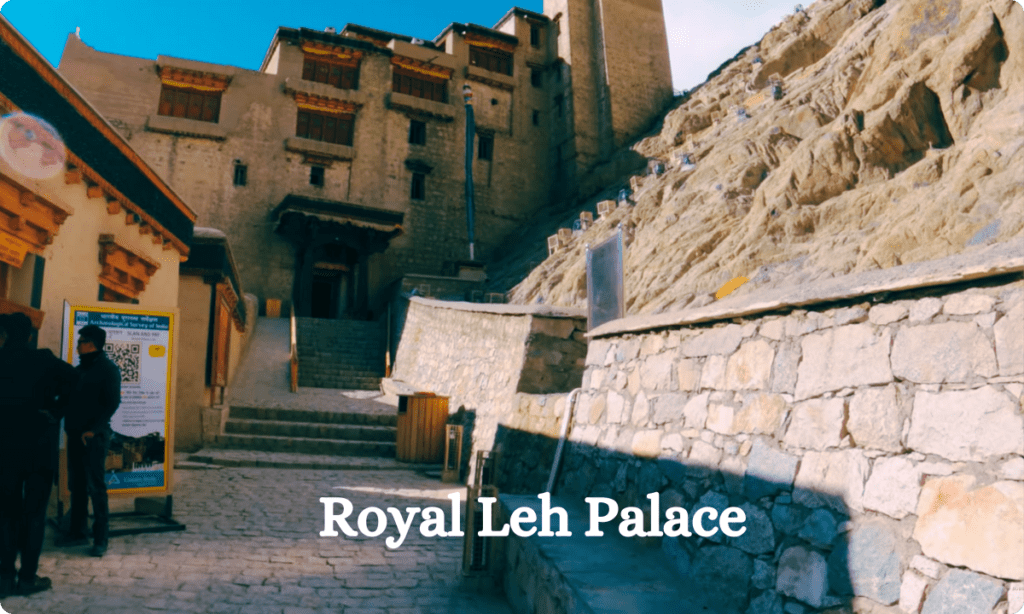
Those who built the Leh Palace are members of the Namgyal Dynasty, who were in constant conflict with the rulers of Kashmir. Tsewang Namgyal, the person who initiated the Namgyal dynasty in the 1550s, designed the palace after Tibet’s Potala Palace. But it was completed by Senge Namgyal, better known as the Lion King, his nephew. It took a long time to complete the palace, and it wasn’t until the 17th century.
The Royal Leh Palace is quite unusual – very different in its style, construction and extremely modest. It has none of that grandeur that I have seen in the Palaces of India and yet, it stands out elegantly owing to its simplicity. The architectural style of the Leh Palace is distinctly Tibetan. Large wooden frames and pillars that are accentuated by powerful dragon carvings at important windows and entrances make this stand out.
The main components of this Ladakh palace are sand, stones, wood, and mud. The creative way these materials are used, almost as though they were meant to give the palace a lovely texture and appearance, astounded me. Here, the mud plaster is known as Mur-Kalak, and the climate was the only factor in the selection of these ingredients. Because wood is an insulator, it kept the interiors warm in the winter and cool and shielded from the hot sun.
19 Gurdwara Pathar Sahib

Gurdwara Shri Pathar Sahib is located 25 kilometers from Leh on the Srinagar-Leh road. It honors Guru Nanak Dev ji, the first guru and the founder of the Sikh religion. It is incredibly beautiful.
The Guru Nanak Dev Ji He traveled through Yarkand to get to Leh during the second journey in 1517 A.D. after visiting Nepal, Sikkim, and Tibet and delivering his sermon on the summer hills. There once lived a vicious demon on top of the hill across from you, who would terrorize people and then devour them after he killed them. When Guru Ji arrived at this location and saw the suffering of the bereaved, he breathed a sigh of relief. However, the demon became enraged and devised a scheme to murder Guru Ji.
When Guru Ji was deeply engrossed in worshiping God one day, the demon saw an opportunity and threw a massive stone (Pathar) at Guru Ji so that so that Guru ji would die under the huge stone However, no one can kill him when the Almighty is protecting him, and that’s when an odd thing happened. The massive stone that struck Guru ji turned into wax, and Guru ji’s body was hit by the wax, but this had no bearing on the worship of Guru ji. Satisfied that Guru Ji was slain, the demon descended close to the stone.
The demon was shocked to see Guru Ji alive, and he kicked the stone with his right leg out of fury. however, the demon’s leg is also hit by the wax. When the demon realized that he had mistakenly attempted to kill a devotee of the Lord, he fell at Guru Ji’s feet and apologized. After opening his eyes, Guru Ji called the demon to dedicate the remainder of his life to helping people, as only then would he reap the benefits.
20 Thiksey Monastery
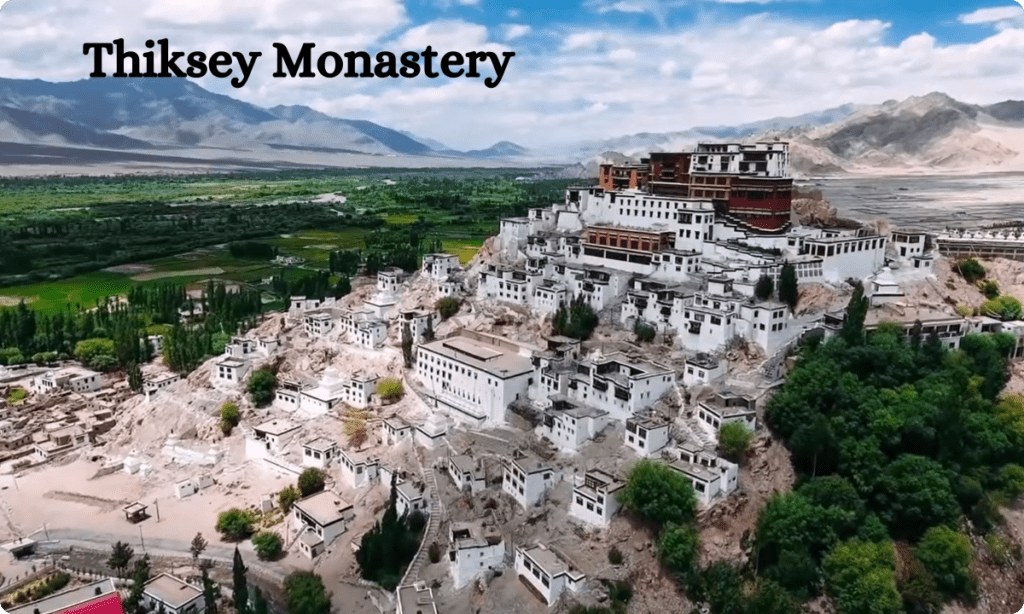
Thiksey Monastery is one of the most popular destinations in all of Ladakh because of three factors. First of all, it’s breathtakingly beautiful. Its breathtaking location is the second, and its closeness to Leh City is the third. Known by another name, Thikse Gompa, this magnificent monastery is the biggest in central Ladakh, set atop a small hill with a 360-degree view of the surrounding valley.
Situated just 19 kilometers away from Leh, it provides some of the best views you will find while traveling. A massive statue of Maitreya Buddha, standing two stories tall (15 meters, or 49 feet) is one of the monastery’s main draws. The largest of these statues can be found in Thiksey Gompa, though there are other large statues in Ladakh as well. It took four years to construct and was intended to honor the 14th Dalai Lama’s 1970 visit.
Temples on the Upper Level
Next, you’ll climb to the highest level and pay a visit to the Lamokhang temple. Please be aware that the top floor, which also houses the head lama’s official residence, is restricted to women.In October or November of each year, the monastery hosts a celebration called Thiksey Gustor.
The festival’s exact dates change every year because it is based on the Tibetan Lunar Calendar. The monks perform a sacred Cham dance in honor of the two-day event.
Best Time to Visit Leh Ladakh
The best time to visit Leh Ladakh is in April and May, so if you’re thinking about going, schedule your trip then. Leh’s temperature stays comfortable during this period, and Srinagar is safe for commuting. During this time, visitors can explore the majority of Leh Ladakh’s attractions.
The ice in Pangong Tso Lake and Tso Moriri begins to melt at the end of April. The first week of May marks the opening of the Srinagar-Leh highway, making it the busiest time of year to visit Ladakh. However, because of snowfall, Khardung-La and Chang-La passes are still closed.
The period of mid-September through mid-October are when the temperature starts to drop. The bare minimum, one degree Celsius.Winter lasts from October to March. The current maximum and minimum temperatures in Celsius are 7 and -6, respectively. When the lakes completely freeze, it’s time to experience the renowned Ladakh Chadar Trek. During the winter, the Zanskar River completely freezes
How should one go about visiting Ladakh?
Flying is the easiest way to get to Ladakh. The main airport serving Ladakh is Kushok Bakula Rimpochee Airport, which is situated in Leh. Regular flights are available from Delhi, Jammu, Srinagar, Mumbai, Kolkata, Chandigarh, and other locations. It’s not a very good option if you would rather travel by rail. Ladakh is not directly accessible by train. Ladakh does not have a train station.
The only train station that can assist you in traveling from Jammu to Ladakh is Jammu Tawi Station. A road trip is highly recommended if you want adventures and breathtaking scenery. The months of May through October are when you can travel on the Ladakh roads. It won’t be accessible due to poor road conditions following that significant snowfall. For a trip to Ladakh, buses, cars, jeeps, and motorcycles are readily available.
Travel Tips to Make Your Ladakh Trip Great
- Any destination can be mentally and physically demanding to travel to if you don’t plan ahead and know where you’re going. Since you are unsure of the kinds of obstacles you will encounter. Being familiar with the fundamentals of the place you are visiting is crucial. Being aware of the local weather, places to stay, customs, and culture makes you an intelligent traveler.
- Ladakh is a unique land. It is critical to be aware of the weather ahead of time. Subzero temperatures can be experienced in some parts of Ladakh; in the winter, some locations see temperatures as low as -30 degrees Celsius. The summertime temperature is pleasant. The weather is unpredictable, so you still need to have some warm clothing on hand. Even in June, snow continues to cover the roadside of the passes. We therefore really cannot say. Prepare your wool clothing.
- An Inner Line permit is necessary for certain locations in Ladakh. Make your exploration plans ahead of time and obtain the Inner Line Permit online or from the Leh DC office.
- When you are in the high-altitude Ladakh region, the oxygen content is low. There will be those of you who get mountain sickness. If you are experiencing severe mountain sickness, travel at an even pace and avoid making quick choices. After a high climb of 2,000 feet, give your body a day or two to rest to allow for acclimatization. Additionally, oxygen cylinders are portable. In your bag, keep any necessary medications. Remain well.
- From any phone shop, obtain the post-paid BSNL mobile connect. It’s the only working mobile connection in Ladakh.
- Have a lot of cash on hand. Ladakh has fewer ATMs than other places. Credit cards are not accepted at most facilities. Leh Market is home to several banks’ ATMs.
- Maintain several copies of your passport, PAN card, and valid ID proof at all times. At military checkpoints, it will be required.
- It’s not a bad idea to research Ladakh’s main tourist destinations, customs, and heritage before visiting. It will make your trip more enjoyable.
- If you wish to travel within Ladakh, you will need to hire a private tour guide. Benefit from local transportation as well, as walking to most locations is not recommended due to altitude sickness.
Conclusion
It’s clear that Leh Ladakh is nothing less than a paradise on Earth as our virtual tour of its captivating landscapes draws to an end. The Top 20 Places to Visit in Leh Ladakh in 2024 offer a journey that defies time and space, an adventure unlike any other.
I hope the pictures and details above on Thiksey Monastery in Ladakh were of help. If you have any questions, you can Social media and I will be happy to answer. You can also consider and asking a question here .
Share the blog “Changpa Tribe: Nomadic Life in Changthang, Ladakh 2024“.on social platforms and help others who wants to visit a offbeat locations.
Frequently Asked Questions (FAQs)
Q.1 why should you travel to Ladakh?
Ans. One of the best places to travel in India is Leh Ladakh. For many, it is the ideal travel destination. It is the most complete destination for all types of tourists because of its high mountain passes, Chadar frozen lake, monasteries, difficult terrain, breathtaking snowfall, and abundance of adventure activities. Here, a visitor will never grow bored. In fact, the Ladakh landscape’s constant texture changes will attract your curiosity at every mile. It is undoubtedly a place that travelers simply must see.
Q.2 For my trip to Ladakh, what should I pack?
Ans. The following is a list of some of the travel basics that you should bring to Ladakh:
- Cozy attire, such as coats, mufflers, and pullovers
- Health Care Package
- Moisturizer and sunscreen
- Personal hygiene products
- Money
- Identity verification
Q.3 Which is the most visited place in Ladakh?
Ans. The most loved attractions in Ladakh are Pangong Tso, Thiksey Gompa, Nubra Valley
Share the blog “Top 20 Places to Visit in Leh Ladakh in 2024“.on social platforms and help others who wants to visit a offbeat locations.


